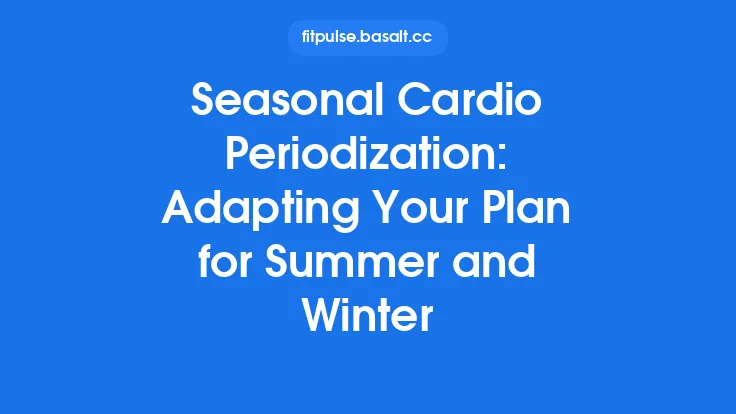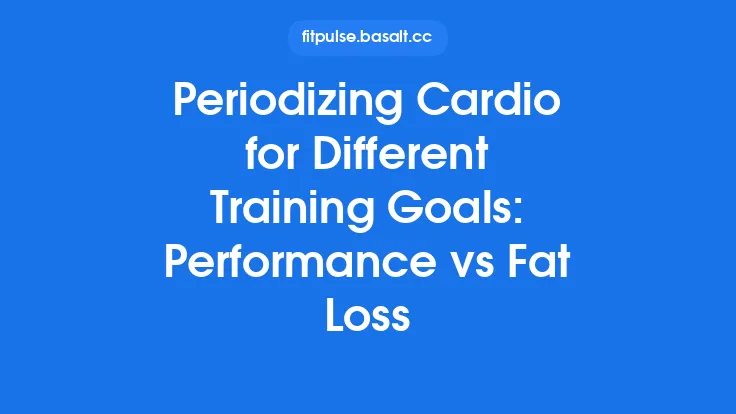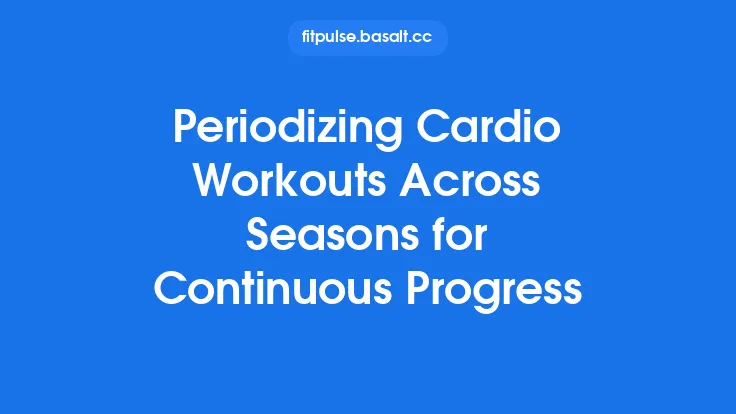Summer cardio can feel like a paradox: the heat that makes a day feel sluggish also offers a unique stimulus that, when managed wisely, can sharpen your cardiovascular engine for the entire year. Below is a comprehensive guide to mastering heat‑smart training techniques that keep you safe, efficient, and ready to perform whether the temperature climbs to 95 °F (35 °C) or drops to a crisp 40 °F (4 °C).
Understanding the Body’s Thermoregulatory Response
When you exercise in warm conditions, your muscles generate heat at a faster rate than they do in cooler environments. The body counters this rise in core temperature through several mechanisms:
- Sweat Production – Evaporation removes heat, but the rate depends on humidity, airflow, and skin surface area.
- Cutaneous Vasodilation – Blood vessels near the skin widen, directing warm blood away from the core to the surface where it can be dissipated.
- Cardiovascular Drift – Over the course of a prolonged session, heart rate gradually climbs even if the external workload stays constant, reflecting the extra circulatory demand for heat loss.
Understanding these processes helps you interpret physiological signals (e.g., an unexpectedly high heart rate) and adjust training variables before fatigue or overheating becomes a problem.
Monitoring Core Temperature and Cardiovascular Load
Modern wearables make it easier than ever to keep tabs on how hard your body is working in the heat. While no single metric tells the whole story, a combination of the following provides a reliable picture:
| Metric | What It Indicates | Practical Use |
|---|---|---|
| Heart Rate (HR) | Overall cardiovascular strain; rises with heat load | Set dynamic HR zones that account for a 5‑10 % upward shift in hot conditions |
| Heart Rate Variability (HRV) | Autonomic balance; lower HRV can signal accumulated stress | Use morning HRV to decide whether to keep the day’s session light |
| Skin Temperature Sensors | Surface heat; useful for gauging cooling efficiency | Spot-check after a run to see if cooling strategies are effective |
| Perceived Exertion (RPE) | Subjective effort; often rises faster in heat | Pair RPE with HR to catch early signs of overheating |
When you notice a consistent drift—e.g., HR climbing 10–15 bpm above your target zone after 20 minutes—consider reducing intensity, increasing rest, or employing additional cooling tactics.
Timing Your Sessions for Optimal Heat Management
The daily temperature curve offers natural windows that minimize thermal stress:
- Early‑Morning (5 am–9 am) – Ambient temperature is lowest, and humidity often higher, which can aid sweat evaporation.
- Late‑Evening (5 pm–8 pm) – After the sun sets, temperatures drop quickly, especially in arid climates.
If your schedule forces you into midday training, plan for extra cooling measures (see next section) and be prepared to shorten the session if core temperature rises too quickly.
Implementing On‑Course Cooling Strategies
Cooling isn’t just a post‑workout luxury; it can be integrated into the workout itself to sustain performance:
- Ice‑Soaked Towels or Bandanas – Place a damp, frozen towel around the neck or forehead for a quick 2–3 °C skin temperature drop.
- Misting Sprays – Lightly misting the torso and arms every 10–15 minutes can enhance evaporative cooling, especially when paired with a gentle breeze (a handheld fan or natural wind).
- Cold Water Immersion Stations – If you have access to a shallow pool or a portable tub, a 30‑second dip at the halfway point can reset core temperature without fully stopping the workout.
- Strategic Shade Utilization – Map out shaded sections of your route or gym layout and plan brief “recovery pauses” under trees, awnings, or indoor corridors.
These tactics are most effective when combined with a modest reduction in intensity (e.g., shifting from a 6‑minute mile to a 6:30‑minute mile) during the cooling interval.
Adjusting Intensity and Volume for Heat
Heat‑induced cardiovascular drift means that the same external workload feels harder. Rather than trying to “push through,” adopt a flexible approach:
- Intensity Scaling – Use a “heat factor” multiplier (e.g., 0.85) on your target pace or power output when the ambient temperature exceeds 85 °F (29 °C).
- Volume Modulation – Reduce total mileage or session length by 10‑20 % on the hottest days, reallocating the saved time to recovery or low‑impact cross‑training.
- Interval Tweaks – Shorten high‑intensity intervals (e.g., 30 seconds instead of 60) and increase recovery periods to allow the body to dissipate heat between efforts.
These adjustments preserve training quality while preventing excessive strain on the cardiovascular and thermoregulatory systems.
Leveraging Low‑Impact Modalities to Preserve Cardio Base
When temperatures soar, substituting a portion of your run or bike session with a low‑impact activity can maintain aerobic conditioning without the same heat burden:
- Rowing Machines – Provide a full‑body cardio stimulus with minimal external heat exposure.
- Elliptical Trainers – Offer a running‑like motion while allowing you to stay in a climate‑controlled environment.
- Swimming (Indoor Pools) – The water’s high heat‑capacity absorbs body heat, keeping core temperature stable even during vigorous effort.
Rotating these modalities into your weekly plan ensures you keep the cardiovascular engine humming while giving your body a break from direct sun exposure.
Post‑Workout Cooling and Recovery
The cooling phase after a hot session is just as critical as the pre‑session preparation. Effective post‑exercise heat removal accelerates recovery and reduces inflammation:
- Cold‑Water Showers – A 3‑minute cool shower (not ice‑cold) lowers skin temperature and helps close blood vessels, facilitating fluid redistribution.
- Compression Garments – Light compression can aid venous return, assisting the body in clearing metabolic waste generated during heat‑stressed cardio.
- Active Recovery – A 10‑minute low‑intensity walk or gentle cycling in a cool environment promotes circulation without adding thermal load.
- Sleep Hygiene – Aim for a cool bedroom temperature (60‑65 °F / 15‑18 °C) to support overnight core temperature reduction, which is essential for hormonal balance and muscle repair.
Consistently applying these recovery steps helps you bounce back faster and prepares you for the next training day, regardless of season.
Translating Summer Heat Gains to Year‑Round Performance
Training in heat can confer physiological benefits that extend into cooler months:
- Improved Plasma Volume – Regular heat exposure expands blood plasma, enhancing stroke volume and oxygen delivery even when temperatures drop.
- Enhanced Sweat Efficiency – The body learns to start sweating earlier and at a higher rate, which can be advantageous during high‑intensity intervals in any climate.
- Cardiovascular Resilience – Repeated exposure to thermal stress strengthens the heart’s ability to maintain output under varied conditions, translating to steadier pacing in winter races.
By preserving these adaptations through strategic off‑season maintenance (e.g., occasional warm‑weather sessions or indoor heat‑controlled workouts), you keep the cardiovascular system primed for peak performance all year.
Practical Checklist for Heat‑Smart Cardio Sessions
| Item | Action |
|---|---|
| Pre‑Session | Check ambient temperature, humidity, and WBGT (Wet‑Bulb Globe Temperature) index. |
| Clothing | Wear light, moisture‑wicking fabrics; avoid heavy layers that trap heat. |
| Hydration | (Brief note) Ensure baseline fluid balance before stepping out; avoid over‑reliance on in‑session drinking. |
| Warm‑Up | Keep it brief and dynamic; focus on movement quality rather than duration. |
| Main Set | Apply heat factor to intensity; incorporate cooling intervals every 10–15 minutes. |
| Monitoring | Track HR, RPE, and skin temperature; adjust on the fly if drift exceeds 10 % of target HR. |
| Cool‑Down | Use a cold‑water shower, light compression, and a 5‑minute easy activity in shade. |
| Recovery | Prioritize sleep in a cool environment; schedule a low‑impact cardio day within 48 hours. |
Final Thoughts
Heat‑smart cardio isn’t about avoiding the sun; it’s about respecting the body’s signals, leveraging technology, and integrating cooling tactics that let you train harder, smarter, and more safely. By mastering the principles outlined above—monitoring physiological responses, timing workouts wisely, adjusting intensity, employing on‑course cooling, and emphasizing recovery—you’ll turn the summer heat from a hindrance into a catalyst for year‑round cardiovascular excellence.
Embrace the challenge, stay vigilant, and let the summer sun forge a stronger, more adaptable cardio foundation that carries you through every season.





